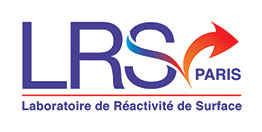Surface Functionalization / Self Assembled Monolayers
The controlled functionalization of materials surfaces is crucial for biological applications we explore like biosensors, biocompatible materials, anti-bacterial surfaces or anti-fouling materials.
For metallic surfaces, particularly gold, the S-Au affinity makes thiol-alkyl, terminated by reactive functions, the ideal candidates for surface modification. These molecules spontaneously adsorb on the surface to form Self-Assembled Monolayers or SAMs. The organization of SAMs is governed by many parameters such as the length and rigidity of the alkyl chains as well as the nature and density of the terminal functions. The characterization of these layers by IR and XPS spectroscopy has allowed us to observe a direct correlation between the organization of SAMs and their interaction with proteins, particularly in terms of density, dispersion and reactivity of the biomolecular layer. The control of this molecular underlayer thus makes it possible to modulate the protein layer and adapt it to the intended application.
On a more fundamental level, despite the numerous studies on SAMs, the mechanisms involved, in particular the nature and influence of the thiol-gold interface, are still subject to debate. The observations of the SAMs led us to investigate this interface to understand the mechanism of assembly and correlate it to parameters such as the length of the chain, as illustrated in the figure above.
For oxide surfaces, functionalization is often achieved through the use of alkoxysilanes that graft onto surface hydroxyl groups forming siloxane bridges, as exemplified for silica. As with thiols, there is a direct relationship between the molecular underlayer and the biomolecular layer. However, there is an additional difficulty in the molecular understanding of the silica/silane interface which lies in the fact that, once the adsorption of silanes has been achieved, it is difficult to distinguish their grafting onto silanols from condensation between silanes at the interface giving oligomers weakly bound to the silica surface. We do explore these phenomena by combining techniques classically devoted to the characterization of planar surfaces with techniques applicable for powders, such as 29Si NMR, which allows for distinguishing grafting from polycondensation.
Also in the section
24.06.2022 - 24.06.2022
Cover in ACS Sensors
Check this beautiful front cover illustrating our work on EV biosensing in neurodegenrative disease conditions
https://pubs.acs.org/doi/full/10.1021/acssensors.1c0265830.04.2022 - 30.04.2022
IEEE Sensors France, Online conference and debate
The conference is now online!
https://www.youtube.com/watch?v=8Op1CWxiUYQ



